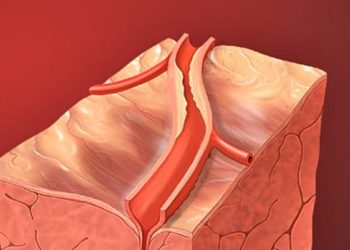CT perfusion-derived angiography aids in detecting arterial occlusion in stroke
1. Timing invariant computed tomography angiography (CTA) derived from computed tomography perfusion can reliably detect large artery occlusions in ischemic stroke, possibly reducing the need for separate CTA in the acute setting.
Evidence Rating: 3 (Good)
Study Rundown: Current stroke imaging research is aimed at identifying patients with acute ischemic stroke that would benefit from a neurointerventional procedure. Once an acute bleed has been ruled out with non-contrast computed tomography (CT), further studies such as CT angiography (CTA), and CT perfusion imaging or diffusion weighted magnetic resonance (MR) is performed to evaluate the location and viability of infarcted and at-risk tissue. Rather than performing separate studies, CT perfusion data can be used to extrapolate timing invariant CTA, which can then be used to evaluate the vasculature for evidence of occlusive thrombus. In this single center prospective study, a total of 47 vessel occlusions were detected among 108 included patients, with similar diagnostic sensitivity and specificity between standard CTA and CT perfusion-derived timing invariant CTA. Overall, standard CTA had a sensitivity of 96% and specificity of 100% compared to a sensitivity of 98% and specificity of 100% in timing insensitive CTA for the detection of vascular occlusion. These results suggest that timing invariant CTA may be an adequate alternative modality for the detection of arterial occlusion in ischemic stroke, possibly reducing the need for a separate CTA, preventing unnecessary radiation exposure and cost. The study was limited in that the CT perfusion data, and therefore the derived CTA was only able to extend 6cm beyond the circle of Willis, preventing evaluation of distal cortical branches and the extracranial circulation. Future studies will need to assess the viability of this imaging modality in patients with lesions in smaller, more distal vascular segments which may be less readily visualized from the derived CTA to determine which patients may safely benefit from completely foregoing standard CTA.
Click to read the study in the American Journal of Neuroradiology
Relevant reading: Timing-Invariant Reconstruction for Deriving High-Quality CT Angiographic Data from Cerebral CT Perfusion Data
In-Depth [case control study]: This single center prospective study identified 115 patients that underwent evaluation for ischemic stroke in a 256-section scanner, with seven patients excluded for technical difficulties in obtaining complete studies. Of the remaining 108 patients, 35 patients had a total of 47 arterial occlusions, with 33 in the middle cerebral artery, 9 in the internal carotid artery, 2 in the anterior cerebral artery, 1 in the basilar artery, and 2 in the posterior cerebral artery. Five randomized and blinded independent neuroradiologists evaluated these studies for the presence and location of lesions in both the CTA and timing-invariant CTA evaluations. For proximal large vessel occlusions, including the internal carotid, basilar, and M1 arteries, the sensitivity and specificity was 100% (95% CI, 100%-100%) for both CTA and timing-invariant CTA. There was good interobserver agreement between studies with mean kappa value=0.76 (range 0.69-0.83, mean agreement 97%, range 96-98%) in the timing-invariant CTA, and a mean kappa value=0.75 (range 0.63-0.85, mean agreement=97%, range 96-98%) in standard CTA. Standard CTA had a sensitivity of 96% (95% CI, 90%-100%) and specificity of 100% (99%-100%) compared to a sensitivity of 98% (95% CI, 94%-100%) and specificity of 100% (95%, 100%-100%) in timing insensitive CTA for the detection of vascular occlusion within the proximal large-vessels including the intracranial ICA, basilar artery and M1 of the MCA.
Image: CC/WikimediaCommons/Hellerhoff
©2015 2 Minute Medicine, Inc. All rights reserved. No works may be reproduced without expressed written consent from 2 Minute Medicine, Inc. Inquire about licensing here. No article should be construed as medical advice and is not intended as such by the authors or by 2 Minute Medicine, Inc.

![The ABCD2 score: Risk of stroke after Transient Ischemic Attack (TIA) [Classics Series]](https://www.2minutemedicine.com/wp-content/uploads/2013/05/web-cover-classics-with-logo-medicine-BW-small-jpg-350x250.jpg)





